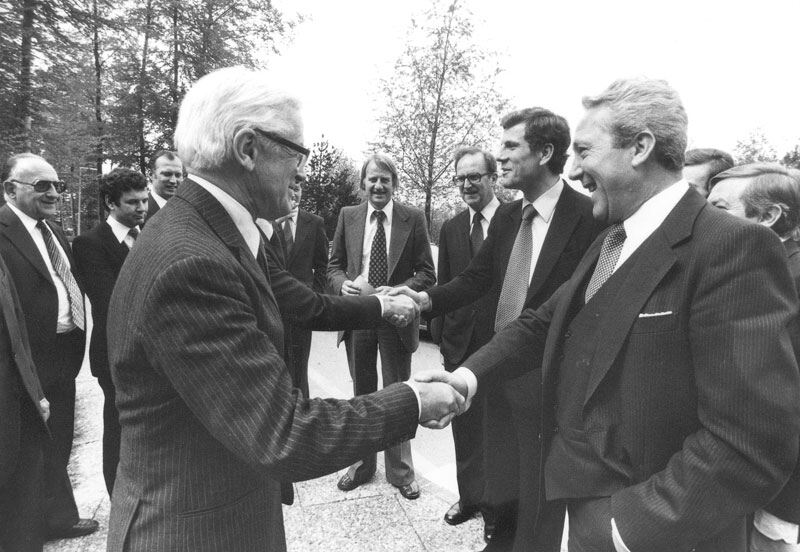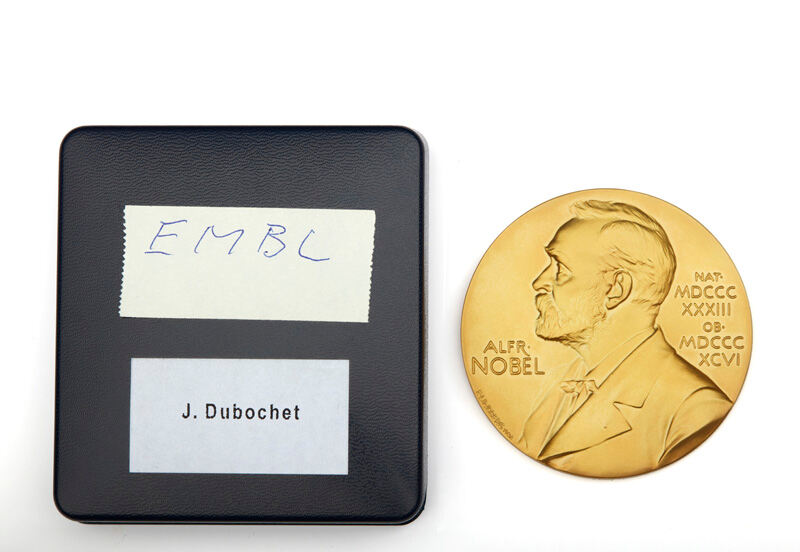
The founding contract of this centre of excellence was signed in July 1974 on a basis of an intergovernmental treaty of nine European countries plus Israel. Since then, the number of member states has increased progressively, with Estonia becoming the 28th member in 2023.
EMBL's founding father John C. Kendrew served as the first Director General of EMBL until 1982, when he was succeeded by Lennart Philipson. The third Director General, Fotis C. Kafatos, served between 1993 and 2005 before Iain Mattaj took up the position. In January 2019, Edith Heard became the fifth and current Director General.
Many scientific breakthroughs have been made at EMBL, including two which have been recognized with Nobel Prizes. Jacques Dubochet was awarded the Nobel Prize in Chemistry in 2017, for using vitrified water to prepare biological samples for electron microscopy; a technique that is still at the heart of cryo-electron microscopy. Christiane Nüsslein-Volhard and Erich Wieschaus were awarded the Nobel Prize in Medicine in 1995, for the first systematic genetic analysis of embryonic development in the fruit fly, in which they identified genes responsible for the body plan of insect embryos.
Today, EMBL is considered Europe's flagship laboratory for basic research in molecular biology, its six European sites attracting both young investigators and established scientists from all over the world.
Timeline of EMBL history
2023 - Estonia joins as a member.
2022 - The historic Molecules to Ecosystems scientific programme commences.
2019 - Professor Edith Heard is appointed as EMBL's fifth Director General. Poland and Lithuania join as members.
2018 - Slovakia and Montenegro join as members.
2017 - Jacques Dubochet receives the Nobel Prize in Chemistry, for his work at EMBL developing cryo-electron microscopy for the high-resolution structure determination of biomolecules in solution. Hungary joins as a member. EMBL opens a site for research on tissue biology and disease modelling in Barcelona, Spain. EMBL's site in Italy becomes EMBL Rome and changes its focus to epigenetics and neurobiology.

2016 - Malta joins as a member.
2014 - The Czech Republic joins as a member.
2007 - Luxembourg joins as a member.
2006 - Croatia joins as a member.
2005 - Professor Iain Mattaj is appointed as EMBL's fourth Director General. Iceland joins as a member.
2003 - Ireland joins as a member.
2002 - EMBL participates in completion and analysis of human and other genomes, made publicly accessible on EMBL-EBI's Ensembl website.
2001 - EMBLEM GmbH, EMBL's technology transfer arm, is established.
1999 - A new programme in Mouse Biology begins operation in Monterotondo near Rome, Italy.
1998 - Portugal joins as a member.
1997 - The EBI is officially opened at Hinxton.
1995 - Christiane Nüsslein-Volhard and Eric Wieschaus receive the Nobel Prize for Medicine for the first systematic genetic analysis of embryonic development in the fruit fly ─ research conducted at EMBL Heidelberg.
1993 - Fotis Kafatos is appointed as the third Director General of EMBL. The EMBL Data Library moves to EMBL-EBI at Hinxton, near Cambridge, UK.
1990 - Belgium joins as a member.
1988 - EMBL and others establish EMBnet, the international sequence database network.
1986 - Spain joins as a member.
1985 - Norway joins as a member.
1984 - EMBL's predoctoral training programme is established.
1984 - Finland and Greece join as members, EMBL's predoctoral training programme is established.
1982 - Lennart Philipson becomes the second Director General. EMBL is reorganised into new scientific research and instrumentation units.
1981 - The EMBL Data Library is founded the first central depository of nucleotide sequence data in the world (precursor to EMBL-EBI).
1976 - An agreement is signed establishing a second outstation at the site of the Institut Laue-Langevin in Grenoble.
1975 - Construction of the Heidelberg facility begins. An official agreement is signed to establish an EMBL outstation at the DESY synchrotron ring in Hamburg.
1974 - On 4 July, with the decision of France to ratify the EMBL Agreement, EMBL becomes a legal entity. Sir John Kendrew is appointed as its first Director General.
1973 - Delegates of the participating countries agree to and sign a draft accord in Geneva to establish a European Molecular Biology Laboratory.
1971 - Heidelberg is chosen as the site for EMBL's main laboratory.
1969 - The first proposals to include outstations in addition to the main laboratory and stronger emphasis on technological development and service functions for the European Molecular Biology Laboratory (EMBL) are made at a meeting at Lake Constance.
1968 - The European Molecular Biology Conference is founded, associating 14 governments with EMBO, providing the organisation with stable funding and scientific independence.
1963 - Scientists at a professional meeting in Ravello, Italy decide to pursue the idea of the laboratory. They form the European Molecular Biology Organization (EMBO) in order to realise this goal. International fellowships and advanced courses are added to the EMBO agenda.
1962 - Leading scientists meet in Geneva to discuss possibility of establishing an international laboratory for molecular biology.